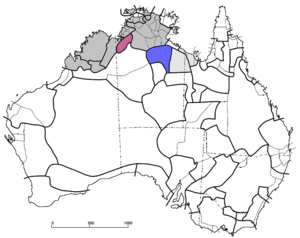Mirndi languages
| Mirndi | |
|---|---|
| Mindi | |
| Geographic distribution: | Northern Territory, Australia |
| Linguistic classification: | One of the world's primary language families |
| Subdivisions: |
|
| Glottolog: | mirn1241[1] |
|
Yirram
Barkly
other non-Pama–Nyungan families | |
The Mirndi or Mindi languages are an Australian language family spoken in the Northern Territory of Australia. The family consists of two sub-groups, the Yirram languages and the Barkly languages some 200 km farther to the southeast, separated by the Ngumpin languages.[2][3] The primary difference between the two sub-groups is that while the Yirram languages are all prefixing like other non-Pama–Nyungan languages, the Barkly languages are all suffixing like most Pama–Nyungan languages.[4]
The name of the family is derived from the dual inclusive pronoun "we" which is shared by all the languages in the family in the form of either "mind-" or "mirnd-".[2]
Classification
The family has been generally accepted after being first established by Neil Chadwick in the early 1980s. The genetic relationship is primarily based upon morphology and not lexical comparison,[4] with the strongest evidence being found among the pronouns. However, "there are very few other systematic similarities in other areas of grammar[, which] throw some doubts on the Mirndi classification, making it less secure than generally accepted."[5]
| Mirndi |
| ||||||||||||||||||||||||
| |
An additional language may be added, Ngaliwurru. However, it is unsure whether it is a language on its own, or merely a dialect of the Jaminjung language.[3][6][7][8][9] The same is true for Gudanji and Binbinka, although these are generally considered dialects of the Wambaya language (and Gudanji may be the same as Ngarnka). These three dialects are collectively referred to as the McArthur River languages.[4][8][10]
Vocabulary
Due to the close contact been the Yirram languages and the Barkly languages, and the Ngumpin languages and other languages as well, many of the cognates that the Yirram and Barkly languages share may in fact be loanwords, especially of Ngumpin origin.[2] For instance, while the Barkly language Jingulu only shares 9% of its vocabulary with its Yirram relative, the Ngaliwurru dialect of the Jaminjung language, it shares 28% with the nearby Ngumpin language Mudburra.[4]
Within the Barkly branch, the Jingulu language shares 29% and 28% of its vocabulary with its closest relatives, the Wambaya language and the Ngarnka language, respectively. The Ngarnka language shares 60% of its vocabulary with the Wambaya language, while the Wambaya language shares 69% and 78% with its dialects, Binbinka and Gudanji, respectively. Finally, these two dialects share 88% of their vocabulary.[10]
References
Notes
- ↑ Nordhoff, Sebastian; Hammarström, Harald; Forkel, Robert; Haspelmath, Martin, eds. (2013). "Mirndi". Glottolog. Leipzig: Max Planck Institute for Evolutionary Anthropology.
- ↑ 2.0 2.1 2.2 Schultze-Berndt 2000, p. 8
- ↑ 3.0 3.1 McConvell, Patrick (2009), "'Where the spear sticks up' – The variety of locatives in placenames in the Victoria River District, Northern Territory", in Koch, Harold; Hercus, Luise, Aboriginal Placenames: Naming and re-naming the Australian landscape, ANU E-Press, pp. 359–402, ISBN 978-1-921666-08-7
- ↑ 4.0 4.1 4.2 4.3 Green, Ian (1995). "The death of 'prefixing': contact induced typological change in northern Australia". Berkeley Linguistics Society 21: 414–425.
- ↑ Bowern, Claire; Koch, Harold (2004), Australian languages: Classification and the comparative method, John Benjamins Publishing Company, pp. 14–15, ISBN 978-1-58811-512-6
- ↑ Pensalfini, Robert J. (2001), "On the Typological and Genetic Affiliation of Jingulu", in Simpson, Jane; Nash, David; Laughren, Mary; Austin, Peter; Alpher, Barry, Forty years on Ken Hale and Australian languages, Pacific Linguistics, pp. 385–399
- ↑ Schultze-Berndt 2000, p. 7
- ↑ 8.0 8.1 Harvey, Mark; Nordlinger, Rachel; Green, Ian (2006). "From Prefixes to Suffixes: Typological Change in Northern Australia". Diachronica 23 (2): 289–311. doi:10.1075/dia.23.2.04har.
- ↑ Schultz-Berndt, Eva F. (2002), "Constructions in Language Description", Functions of Language 9 (2): 267–308
- ↑ 10.0 10.1 Pensalfini, Robert J. (1997), Jingulu Grammar, Dictionary, and Texts, Massachusetts, United States: Massachusetts Institute of Technology, p. 19
General
- Schultze-Berndt, Eva F. (2000), Simple and Complex Verbs in Jaminjung – A Study of event categorisation in an Australian language
| ||||||||||||||||||||||||
